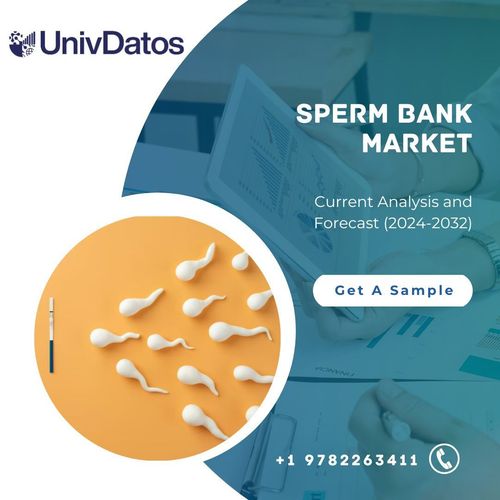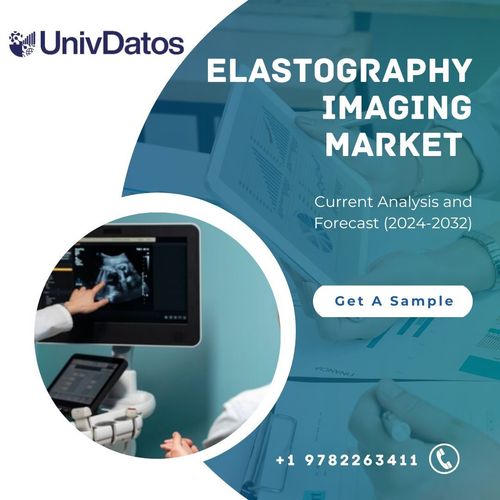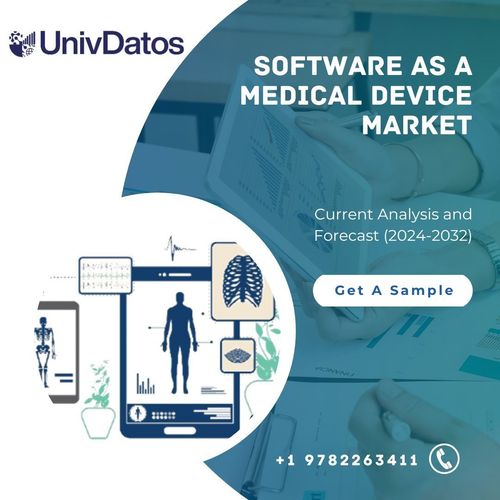Aesthetic Devices Market: Current Analysis and Forecast (2021-2027)
Emphasis By Product (Aesthetic Laser & Energy Devices, Skin Tightening & Body Contouring Devices, Aesthetic Implants, Facial Aesthetic Devices); By Application (Facial & Body Contouring, Facial & Skin Rejuvenation, Hair Removal, Breast Enhancement, Scar Treatment, Reconstructive Surgery, Others); By End-User (Hospitals, Dermatology Clinics, Cosmetic Centers, Others) and Region/Country.
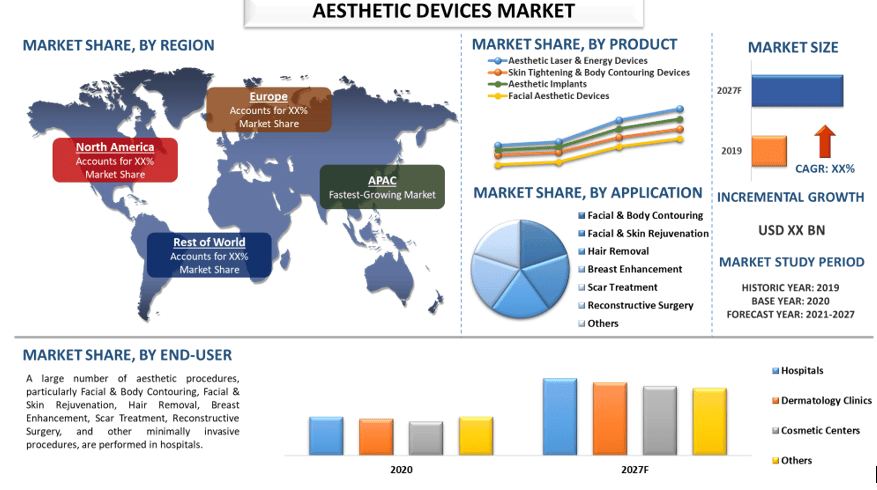
The aesthetic devices market is expected to witness a CAGR of around 11% during the forecast period (2021–2027). Aesthetic devices are typically used to improve the appearance and impact the structure or function of the body. The increasing use of minimally invasive procedures has been shifted to traditional methods for aesthetic surgery techniques including laser & energy-based devices, skin tightening & body contouring devices, aesthetic implants, and facial aesthetic devices. These devices are the medical devices used for surgical or non-surgical procedures, including reducing fat, plastic surgery, anti-aging, unwanted hair removal, skin tightening, and aesthetic implants among others. In addition, major players are launching new devices for aesthetic procedures.
Some of the major companies operating in the aesthetic devices market include AbbVie Inc., Bausch Health Companies Inc., Henry Schein Inc., Merz Pharma GmbH & Co. KGaA, Candela Laser Corporation, Aerolase Corporation, Aesthetic Technology Limited, Aesthetics Biomedical, Biotec Italia Srl, and Cutera Inc.
Insights Presented in the Report
“Amongst Product, the facial aesthetic devices category accounted for the majority share in the market in 2020”
Based on product, the aesthetic devices market is segmented into aesthetic laser & energy devices, skin tightening & body contouring devices, aesthetic implants, and facial aesthetic devices. In 2020, the facial aesthetic devices category is anticipated to witness a significant growth rate during the forecast period. This is mainly due to the increasing use of visible light lasers, intense pulsed light (IPL), and radio frequency devices in non-surgical circumferential reduction, cellulite reduction, skin tightening, wrinkle reduction, etc. Furthermore, in 2020, according to the International Society of Aesthetic Plastic Surgery (ISAPS) global survey, there were 515,819 fat grafting procedures performed worldwide.
“Amongst Application, the Facial & Body Contouring category is expected to witness the highest CAGR during the forecast period”
Based on application, the aesthetic devices market is segmented into facial & body contouring, facial & skin rejuvenation, hair removal, breast enhancement, scar treatment, reconstructive surgery, and others. In 2020, the facial & body contouring category is anticipated to witness a significant growth rate during the forecast period. facial & body contouring is the process of molding the body shape after significant weight loss from the face and overall body with the help of some medical equipment and devices such as Radio Frequency Device (RF) and body shaper machines developed by companies. Furthermore, in 2020, according to the International Society of Aesthetic Plastic Surgery (ISAPS) global survey, there were 560,464 nonsurgical fat reduction procedures performed worldwide.
“North America to witness significant growth during the forecast period”
For a better understanding of the market, the report provides a detailed analysis of major regions and countries including North America (U.S., Canada, Rest of America); Europe (Germany, U.K., France, Spain, Italy, Rest of Europe); Asia-Pacific (China, India, Japan, Australia, South Korea, Rest of Asia-Pacific) and Rest of World. In 2020, North America accounted for a significant market share. This is mainly due to the higher per capita income and the availability of advanced healthcare infrastructure coupled with increasing awareness about various aesthetic procedures in the region. For instance, as per the 2020 Plastic Surgery Statistics Report by the American Society of Plastic Surgeons, there were 193,073 breast augmentation procedures performed in the U.S.
Reasons to buy this report:
- The study includes market sizing and forecasting analysis validated by authenticated key industry experts.
- The report presents a quick review of overall industry performance at one glance.
- The report covers an in-depth analysis of prominent industry peers with a primary focus on key business financials, product portfolio, expansion strategies, and recent developments.
- Detailed examination of drivers, restraints, key trends, and opportunities prevailing in the industry.
- The study comprehensively covers the market across different segments.
- Deep dive regional level analysis of the industry.
Customization Options:
The aesthetic devices market can further be customized as per the requirement or any other market segment. Besides this, UMI understands that you may have your own business needs, hence feel free to connect with us to get a report that completely suits your requirements.
Table of Contents
Analyzing the historical market, estimating the current market, and forecasting the future market of the aesthetic devices market were the three major steps undertaken to create and analyze the adoption of the aesthetic devices market in major regions globally. Exhaustive secondary research was conducted to collect the historical market numbers and estimate the current market size. Secondly, to validate these insights, numerous findings and assumptions were taken into consideration. Moreover, exhaustive primary interviews were also conducted, with industry experts across the value chain of the aesthetic devices market. Post assumption and validation of market numbers through primary interviews, we employed a top-down/bottom-up approach to forecasting the complete market size. Thereafter, market breakdown and data triangulation methods were adopted to estimate and analyze the market size of segments and sub-segments of the industry pertains to. Detailed methodology is explained below:
Seek More Details About Research Methodology
Analysis of Historical Market Size
Step 1: In-Depth Study of Secondary Sources:
Detail secondary study was conducted to obtain the historical market size of the aesthetic devices market through company internal sources such as annual reports & financial statements, performance presentations, press releases, etc., and external sources including journals, news & articles, government publications, competitor publications, sector reports, third-party database, and other credible publications.
Step 2: Market Segmentation:
After obtaining the historical market size of the aesthetic devices market, we conducted a detailed secondary analysis to gather historical market insights and share for different segments & sub-segments for major regions. Major segments are included in the report as product, application, and end-user. Further country-level analyses were conducted to evaluate the overall adoption of testing models in that region.
Step 3: Factor Analysis:
After acquiring the historical market size of different segments and sub-segments, we conducted a detailed factor analysis to estimate the current market size of the aesthetic devices market. Further, we conducted factor analysis using dependent and independent variables such as various product, application, and end-user of the aesthetic devices market. A thorough analysis was conducted for demand and supply-side scenarios considering top partnerships, mergers and acquisitions, business expansion, and product launches in the aesthetic devices market sector across the globe.
Current Market Size Estimate & Forecast
Current Market Sizing: Based on actionable insights from the above 3 steps, we arrived at the current market size, key players in the aesthetic devices market, and market shares of the segments. All the required percentage shares split, and market breakdowns were determined using the above-mentioned secondary approach and were verified through primary interviews.
Estimation & Forecasting: For market estimation and forecast, weights were assigned to different factors including drivers & trends, restraints, and opportunities available for the stakeholders. After analyzing these factors, relevant forecasting techniques i.e., the top-down/bottom-up approach were applied to arrive at the market forecast about 2027 for different segments and sub-segments across the major markets globally. The research methodology adopted to estimate the market size encompasses:
- The industry’s market size, in terms of revenue (USD) and the adoption rate of the aesthetic devices market across the major markets domestically
- All percentage shares, splits, and breakdowns of market segments and sub-segments
- Key players in the aesthetic devices market in terms of solutions offered. Also, the growth strategies adopted by these players to compete in the fast-growing market
Market Size and Share Validation
Primary Research: In-depth interviews were conducted with the Key Opinion Leaders (KOLs) including Top Level Executives (CXO/VPs, Sales Head, Marketing Head, Operational Head, Regional Head, Country Head, etc.) across major regions. Primary research findings were then summarized, and statistical analysis was performed to prove the stated hypothesis. Inputs from primary research were consolidated with secondary findings, hence turning information into actionable insights.
Split of Primary Participants in Different Regions
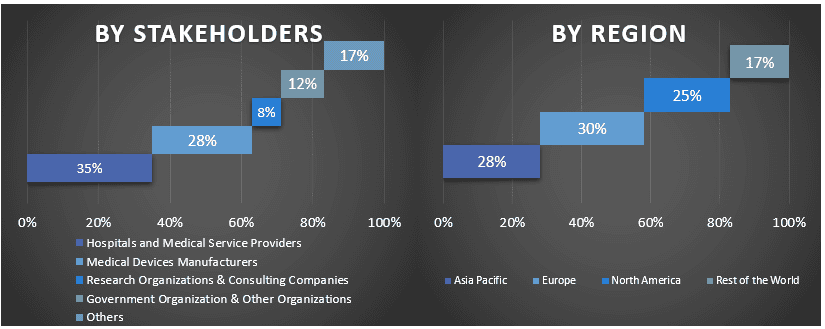
Market Engineering
The data triangulation technique was employed to complete the overall market estimation and to arrive at precise statistical numbers for each segment and sub-segment of the aesthetic devices market. Data was split into several segments & sub-segments post studying various parameters and trends in the areas of product, application, and end-user in the aesthetic devices market.
The main objective of the aesthetic devices market Study
The current & future market trends of the aesthetic devices market were pinpointed in the study. Investors can gain strategic insights to base their discretion for investments on the qualitative and quantitative analysis performed in the study. Current and future market trends determined the overall attractiveness of the market at a regional level, providing a platform for the industrial participant to exploit the untapped market to benefit from a first-mover advantage. Other quantitative goals of the studies include:
- Analyze the current and forecast market size of the aesthetic devices market in terms of value (USD). Also, analyze the current and forecast market size of different segments and sub-segments
- Segments in the study include areas of product, application, and end-user.
- Define and analysis of the regulatory framework for the aesthetic devices market industry.
- Analyze the value chain involved with the presence of various intermediaries, along with analyzing customer and competitor behaviors of the industry.
- Analyze the current and forecast market size of the aesthetic devices market for the major region.
- Major regions and countries studied in the report include North America (U.S., Canada, Rest of America); Europe (Germany, U.K., France, Spain, Italy, Rest of Europe); Asia-Pacific (China, India, Japan, Australia, South Korea, Rest of Asia-Pacific) and Rest of World.
- Company profiles of the aesthetic devices market and the growth strategies adopted by the market players to sustain in the fast-growing market
- Deep dive regional level analysis of the industry
Related Reports
Customers who bought this item also bought

